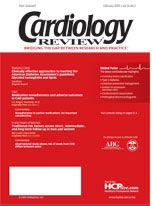Publication
Article
Are all statins alike? How important is pleiotropy?
A s documented in several large population-based clinical trials, the widespread use of HMG-CoA reductase inhibitors (statins) has the potential to dramatically reduce the incidence of cardiovascular disease.1-5 Statins work by inhibiting the rate-limiting step of cholesterol synthesis, HMG-CoA reductase-dependent cholesterol biosynthesis. This inhibition results in a decrease in hepatocellular cholesterol, which causes an upregulation of hepatic low-density lipoprotein (LDL) cholesterol receptors, with the result that more LDL is removed from
the circulation and serum LDL levels are lowered. This cholesterol-lowering effect has been assumed to underlie the clinical efficacy of
the class of drugs; however, other pleiotropic
effects are increasingly being acknowledged.6 These effects include improvement of en-
dothelial dysfunction, increased nitric oxide bioavailability, antioxidant effects, antiinflammatory properties, and stabilization of atherosclerotic plaques, all of which have obvious relevance in patients with subclinical coronary artery disease.
The present study by Yokoyama and colleagues (page 13) indirectly investigated the statin effect on endothelial dysfunction. The study was designed to test whether there are differences in myocardial blood flow (MBF) and myocardial vasodilatation index (MVI) in patients with presumed subclinical coronary disease, and whether these indices can be selectively influenced by treatment with statins. MBF was determined by [13N]ammonia positron emission tomography (PET) scanning in 44 asymptomatic patients with hypercholesterolemia before and after lipid-lowering treatment and contrasted with 22 normal controls. An equal number of hypercholesterolemic patients were randomly assigned to low doses of pravastatin (Pravachol) and simvastatin (Zocor) and were treated for 10 months, yielding equivalent cholesterol lowering. Both groups and controls underwent myocardial perfusion scanning by [13N] PET at rest and with dipyridamole before and after treatment with their respective statins. MBF and MVI were decreased significantly before treatment as compared with controls in both hypercholesterolemic groups. Only the simvastatin group showed a statistically significant improvement in these measures after treatment.
The data suggest that simvastatin, not pravastatin, asserts pleiotropic effects that improved MVI since cholesterol and LDL lowering were similar in both groups. It is certainly possible that these results are mediated by innate differences in the statins. Pravastatin is a hydrophilic statin, while simvastatin is lipophilic, and in vitro studies have suggested that lipophilic and not hydrophilic agents are more effective in activating inducible nitric oxide synthase.7 In rat blood vessels, acute vasodilatation was achieved in a dose-dependent fashion with lipophilic statins but not hydrophilic statins.8 Any extrapolation from in vitro studies, however, should be tempered by the fact that the drug levels required to bring about pleiotropic effects are far greater than those that can be achieved in vivo. Given this, the distinction between simvastatin and pravastatin may be a reflection of relative drug potency (very low levels of statins were employed in this study) and not innate biologic differences, a conclusion that is supported by the fact that more potent hydrophilic statins such as ro-suvastatin have also shown similar pleiotropic effects as compared with lipophilic statins.9,10
While this study suggests that myocardial vasodilatation, which is a marker of endothelial dysfunction, is selectively improved with simvastatin, the results should be viewed with caution. In clinical trials, both simvastatin and pravastatin have been shown to decrease cardiovascular events, a fact that would seem to cede more bio-
logic importance to the primary lipid lowering class effect than the pleiotropic effect. It is also possible that the differences in the treatment groups in this small study were not related to drug effects but to differences in the patients studied. Although the authors made a good-faith effort to randomize the patients appropriately (and in fact baseline lipoprotein profiles were similar), there may well have been varying levels of endothelial dysfunction or inflammation (as well as age and sex differences) in the two treatment groups that were not appreciated. In fact, there was improvement in MVI in eight of the 22 patients treated with pravastatin and no improvement in six of the patients treated with simvastatin. This could possibly have been acknowledged had the authors chosen a more complex double-blind crossover design.
While it appears likely (albeit as yet not conclusively demonstrated) that all statins are not the same, the more compelling question, perhaps, is which of the several pleiotropic effects associated with this class of drugs (if any) are clinically important. Addressing this question is critically important and not at all straightforward.
